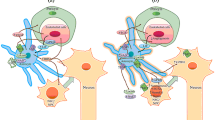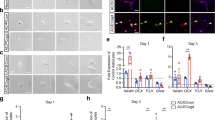Abstract
The highly impermeable tight junctions between endothelial cells forming the capillaries and venules in the central nervous system (CNS) of higher vertebrates are thought to be responsible for the blood-brain barrier1,2 that impedes the passive diffusion of solutes from the blood into the extracellular space of the CNS3–6. The ability of CNS endothelial cells to form a blood-brain barrier is not intrinsic to these cells but instead is induced by the CNS environment: Stewart and Wiley7 demonstrated that when avascular tissue from 3-day-old quail brain is transplanted into the coelomic cavity of chick embryos, the chick endothelial cells that vascularize the quail brain grafts form a competent blood–brain barrier; on the other hand, when avascular embryonic quail coelomic grafts are transplanted into embryonic chick brain, the chick endothelial cells that invade the mesenchymal tissue grafts form leaky capillaries and venules. It is, however, not known which cells in the CNS are responsible for inducing endothelial cells to form the tight junctions characteristic of the blood–brain barrier. Astrocytes are the most likely candidates since their processes form endfeet that collectively surround CNS microvessels8,9. In this report we provide direct evidence that astrocytes are capable of inducing blood–brain barrier properties in non-neural endothelial cells in vivo.
Similar content being viewed by others
References
Reese, T. S. & Karnovsky, M. J. J. Cell Biol. 34, 207–217 (1967).
Nagy, Z., Peters, H. & Huettner, I. Lab. Invest. 50, 313–322 (1984).
Crone, C. Acta physiol. Scand. 64, 407–417 (1965).
Bradbury, M. W. B. Circulation Res. 57, 213–222 (1985).
Abbott, N. J. Trends Neurosci. 9, 3–7 (1986).
Betz, A. L. & Goldstein, G. W. A. Rev. Physiol. 48, 241–250 (1986).
Stewart, P. A. & Wiley, M. J. Devl Biol. 84, 183–192 (1981).
Ramon y Cajal, S. in Histologie du systeme nerveux de l'homme et des vertebres Vol. 1, 230–252, 2nd edn (CSDIC, Instituto Ramon y Cajal, Madrid, 1972).
Peters, A., Palay, S. L. & DeWebster, H. in The Fine structure of the nervous system: The neurons and supporting cells 231–263 (Saunders, Philadelphia, 1976).
Raff, M. C., Abney, E. R. & Fok-Seang, J. Cell 42, 61–69 (1985).
Bignami, A., Eng, L. F., Dahl, D. & Uyeda, C. T. Brain Res. 43, 429–435 (1972).
Raff, M. C., Abney, E. R., Cohen, J., Lindsay, K. & Noble, M. J. Neurosci. 3, 1289–1300 (1983).
Olson, L., Seiger, A. & Stroemberg, I. in Advances in Cellular Neurobiology Vol. 4 (eds Federoff, S. & Hertz, L.) 407–422 (Academic New York, 1983).
Freedman, F. B. & Johnson, J. A. Am. J. Physiol. 216, 675–681 (1969).
Raff, M. C. et al. Brain Res. 174, 283–308 (1979).
Saria, A. & Lundberg, J. M. J. Neurosci. Meth. 8, 41–49 (1983).
Hsu, S. M., Raine, L. & Fanger, H. J. Histochem. Cytochem. 29, 577–584 (1981).
Tao-Cheng, J.-H., Nagy, Z. & Brightman, W. Anal. Rec. 214, 131A (1986).
DeBault, L. E. & Cancilla, P. A. Science 207, 653–655 (1980).
Beck, D. W., Vinters, H. V., Hart, M. N. & Cancilla, P. A. J. Neuropath. exp. Neurol. 43, 219–224 (1984).
McCarthy, K. D. & de Vellis, J. J. Cell Biol. 85, 890–902 (1980).
Noble, M., Fok-Sang, J. & Cohen, J. J. Neurosci. 4, 1892–1903 (1984).
Raff, M. C., Abney, E. R. & Miller, R. H. Devl Biol. 106, 53–60 (1984).
Pruss, R. M. Nature 280, 688–690 (1979).
Eisenbarth, G. S., Walsh, F. S. & Nirenberg, M. Proc. natn. Acad. Sci. U.S.A. 76, 4913–4917 (1979).
Ranscht, B., Clapshaw, P. A., Price, J., Noble, M. & Siefert, W. Proc. natn. Acad. Sci. U.S.A. 79, 2707–2713 (1982).
Pino, R. M. & Thouron, C. L. J. Histochem. Cytochem. 31, 411–416 (1983).
Sternberger, L. A. Immunocytochemistry, 3rd edn, (Wiley, New York, 1986).
New, D. A. T. The Culture of Vertebrate Embryos 71–73 (Academic, London, 1966).
Author information
Authors and Affiliations
Rights and permissions
About this article
Cite this article
Janzer, R., Raff, M. Astrocytes induce blood–brain barrier properties in endothelial cells. Nature 325, 253–257 (1987). https://doi.org/10.1038/325253a0
Received:
Accepted:
Issue Date:
DOI: https://doi.org/10.1038/325253a0
- Springer Nature Limited
This article is cited by
-
Brain Pathology in COVID-19: Clinical Manifestations and Potential Mechanisms
Neuroscience Bulletin (2024)
-
Factors influencing the degree of disability in patients with neuromyelitis optica spectrum disorders
European Journal of Medical Research (2023)
-
A flow cytometry-based protocol for syngenic isolation of neurovascular unit cells from mouse and human tissues
Nature Protocols (2023)
-
The contribution of inflammatory astrocytes to BBB impairments in a brain-chip model of Parkinson’s disease
Nature Communications (2023)
-
Histone Deacetylase 3 Inhibition Decreases Cerebral Edema and Protects the Blood–Brain Barrier After Stroke
Molecular Neurobiology (2023)





